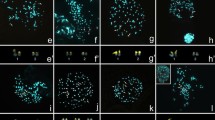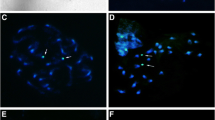Abstract
The tribe Leucocoryneae is taxonomically and cytogenetically complex, mainly due to its extraordinary morphological and karyological variation. Robertsonian translocations had long been recognized as a central factor contributing to karyotype diversity within the Leucocoryneae, but so far no major tendency prevailing on the observed complexity of karyotype formula among species has been identified. The assessment of nuclear DNA contents by flow cytometry using propidium iodide in 23 species, representing all genera within the tribe, showed a monoploid genome size variation of 1Cx = 9.07–30.46 pg denoting a threefolds fluctuation. A highly significant linear association between the average DNA content per chromosome arm (2C/FN) and the monoploid genome size (1Cx) is reported for the first time and identified as a novel indicator of a trend governing karyotype diversity within Leucocoryneae. This trend shows that a reduction in DNA content per chromosome arm is influencing and has shaped karyotype evolution of different monophyletic groups within the tribe despite the complex karyotype diversity and apparently contrasting patterns of genome sizes.
Similar content being viewed by others
References
Araneda L, Salas P, Mansur L (2004) Chromosome numbers in the Chilean endemic genus Leucocoryne (Huilli). J Am Soc Hortic Sci 129:77–80
Arroyo-Leuenberger SC, Sassone AB (2016) An annotated checklist of the genus Tristagma (Amaryllidaceae, Allioideae). Phytotaxa 277:21–35
Bennett MD, Leitch IJ (2012) Plant DNA C-values database (release 6.0, Dec. 2012). http://www.kew.org/cvalues/. Accessed 28 Apr 2017
Bennetzen JL. Jianxin MA, Devos KM (2005) Mechanisms of recent genome size variation in flowering plants. Ann Bot 95:127–132. doi:10.1093/aob/mci008
Chalup L, Grabiele M, Neffa VS, Seijo G (2014) DNA content in South American endemic species of Lathyrus. J Plant Res 127:469–480. doi:10.1007/s10265-014-0637-z
Crosa O (1972) Estudios cariológicos en el género Nothoscordum (Liliaceae). Bol Fac Agron Univ Montev 122:3–8
Crosa O (1974) Un híbrido natural en el género Nothoscordum (Liliaceae). Bol la Soc Argent Bot 15:471–477
Crosa O (1975a) Las especies unifloras del género Nothoscordum Kunth y el género Ipheion Raf. de la tribu Allieae (Liliaceae). Darwiniana 19:335–344
Crosa O (1975b) Zoellnerallium, un género nuevo para la tribu Allieae (Liliaceae). Darwiniana 19:331–334
Crosa O (1981) Los cromosomas de cinco especies del genero Tristagma (Liliaceae). Darwiniana 23:361–366
Crosa O (1988) Los cromosomas de nueve especies del género chileno Leucocoryne Lindley, (Allieae–Alliaceae). Bol Investig Montev Urug 17:1–12
Crosa O (2004) Segunda especie y justificación del género Zoellnerallium (Alliaceae) Darwiniana 42:165–168
Crosa O, Marchesi E (2002) Presencia de Ipheion tweedieanum (Baker) Traub (Alliaceae) en Uruguay. Agrociencia 6:92–97
Di Rienzo JA, Casanoves F, Balzarini MG et al (2012) InfoStat versión 2012. Grupo InfoStat, FCA, Universidad Nacional de Córdoba
Doležel J, Greilhuber J, Lucretti S, Meister A, Lysák MA, Nardi L, Obermayer R (1998) Plant genome size estimation by flow cytometry: inter-laboratory comparison. Ann Bot 82:17–26. doi:10.1093/oxfordjournals.aob.a010312
Guaglianone ER (1972) Sinopsis de las especies de Ipheion Raf. y Nothoscordum Kunth (Liliáceas) de Entre Ríos y regiones vecinas. Darwiniana 17:159–240
Hijmans RJ, Elith J (2016) Species distribution modeling with R. https://cran.r-project.org/web/packages/dismo/vignettes/sdm.pdf. Accessed 20 Apr 2017
Jang TS, Emadzade K, Parker J, Temsch EM, Leitch AR, Speta F, Weiss-Schneeweiss H (2013) Chromosomal diversification and karyotype evolution of diploids in the cytologically diverse genus Prospero (Hyacinthaceae). BMC Evol Biol 13:136
Jara-Arancio P, Jara-Seguel P, Palma-Rojas C et al (2012) Karyological study in fifteen Leucocoryne taxa (Alliaceae). Biologia (Bratisl) 67:289–295. doi:10.2478/s11756-012-0001-5
Jones K (1998) Robertsonian fusion and centric fission in karyotype evolution of higher plants. Bot Rev 64:273–289
Leitch AR, Leitch IJ (2008) Genomic plasticity and the diversity of polyploid plants. Science 320:481–483
Leitch IJ, Leitch AR (2013) Genome size diversity and evolution in land plants. In: Leitch IJ (ed) Plant genome diversity, vol. 2. Springer, Vienna, pp 307–322
Meric C, Dane F (2005) Determination of Ploidy levels in Ipheion uniflorum (R.C. Graham) Rafin (Liliaceae). Acta Biol Hung 56:129–136
Montes L, Nuciari MC (1987) Nothoscordum montevidense sensu lato: New polyploid cytotypes in Argentina. Aliso 11:635–640
Nassar NMA, Aguiar MLR (1978) Multiple karyotypes in individuals of Nothoscordum fragrans (Liliaceae). Caryologia 31:7–14
Nuñez O (1990) Evolución cariotípica en el género Nothoscordum. Monogr la Acad Nac Cienc Exactas Físicas Nat 5:55–61
Nuñez O, Frayssinet N, Rodriguez RH, Jones K (1974) Cytogenetic studies in the genus Nothoscordum Kunth: the N. inodorum polyploidy complex. Caryologia 27:403–441
Otto F (1990) DAPI staining of fixed cells for high-resolution flow cytometry of nuclear DNA. In: Darzynkiewiez Z, Crissman HA, Robinson JP (eds) Methods in cell biology. Academic Press, San Diego, pp 105–110. doi:10.1016/S0091-679X(08)60516-6
Palomino G, Romo V, Ruenes R (1992) Fisiones céntricas en cromosomas metacéntricos de Nothoscordum bivalve (Alliaceae) de México. Bol Soc Bot Mex 52:121–124
Pellicer J, Hidalgo O, Walker J, Chase MW, Christenhusz MJ, Shackelford G, Fay MF (2017) Genome size dynamics in tribe Gilliesieae (Amaryllidaceae, subfamily Allioideae) in the context of polyploidy and unusual incidence of Robertsonian translocations. Bot J Linnean Soc 184:16–31
Peruzzi L, Leitch IJ, Caparelli KF (2009) Chromosome diversity and evolution in Liliaceae. Ann Bot 103:459–475. doi: 10.1093/aob/mcn230
Pires CJ, Maureira IJ, Givnish TJ et al (2006) Phylogeny, genome size, and chromosome evolution of Asparagales. Aliso 22:285–302
Poggio L, Realini MF, Fourastié MF et al (2014) Genome downsizing and karyotype constancy in diploid and polyploid congeners: a model of genome size variation. AoB Plants. doi:10.1093/aobpla/plu029
Puttick MN, Clark J, Donoghue PC (2015) Size is not everything: rates of genome size evolution, not C-value, correlate with speciation in angiosperms. Proc R Soc B 282:20152289
R Development Core Team (2016) R: a language and environment for statistical computing. R Foundation for Statistical Computing, Vienna
Rice A, Glick L, Abadi S, Einhorn M, Kopelman NM, Salman-Minkov A, Mayzel J, Chay O, Mayrose I (2014) The chromosome counts database (CCDB) a community resource of plant chromosome numbers. New Phytol. doi:10.1111/nph.13191
Samad NA, Dagher-Kharrat MB, Hidalgo O, El Zein R, Douaihy B, Siljak-Yakovlev S (2016) Unlocking the karyological and cytogenetic diversity of iris from Lebanon: oncocyclus section shows a distinctive profile and relative stasis during its continental radiation. PloS One 11:e0160816
Sassone AB (2017) Evolutionary and systematic studies in genus Tristagma (Amaryllidaceae). Universidad de Buenos Aires
Sassone AB, Arroyo-Leuenberguer S, Giussani LM (2014a) Nueva Circunscripción de la tribu Leucocoryneae (Amaryllidaceae, Allioideae). Darwiniana Nueva Ser 2:197–206. doi:10.14522/darwiniana.2014.22.584
Sassone AB, Giussani LM, Guaglianone ER (2014b) Beauverdia, a resurrected genus of Amaryllidaceae (Allioideae, Gilliesieae). doi:10.1600/036364414X681527
Sassone AB, Belgrano MJ, Guaglianone ER (2015) The reinstatement of Latace Phil. (Amaryllidaceae, Allioideae) Phytotaxa 239:253–263
Schubert I, Vu GTH (2016) Genome stability and evolution: attempting a holistic view. Trends Plant Sci 21:749–757. doi:10.1016/j.tplants.2016.06.003
Soltis DE, Soltis PS, Bennett MD, Leitch IJ (2003) Evolution of genome size in the angiosperms. Am J Bot 90:1596–1603
Soltis DE, Albert VA, Leebens-Mack J et al (2009) Polyploidy and angiosperm diversification. Am J Bot 96:336–348. doi:10.3732/ajb.0800079
Soltis PS, Marchant DB, Van de Peer Y, Soltis DE (2015) Polyploidy and genome evolution in plants. Curr Opin Genet Dev 35:119–125. doi:10.1016/j.gde.2015.11.003
Souza LGR (2012) Filogenia molecular, citotaxonomia e evolução cariotípica da subfamília Gilliesioideae (Alliaceae). Universidade Federal do Pernambuco
Souza LGR, Crosa O, Winge H, Guerra M (2009) The karyotype of Nothoscordum arenarium Herter (Gilliesioideae, Alliaceae): a populational and cytomolecular analysis. Genet Mol Biol 32:111–116. doi:10.1590/S1415-47572009005000016
Souza LGR, Crosa O, Guerra M (2010) Karyological circumscription of Ipheion Rafinesque (Gilliesioideae, Alliaceae). Plant Syst Evol 287:119–127. doi:10.1007/s00606-010-0304-3
Souza LGR, Crosa O, Speranza P, Guerra M (2012) Cytogenetic and molecular evidence suggest multiple origins and geographical parthenogenesis in Nothoscordum gracile (Alliaceae). Ann Bot 109:987–999. doi:10.1093/aob/mcs020
Souza G, Crosa O, Guerra M (2015) Karyological, morphological, and phylogenetic diversification in Leucocoryne Lindl (Allioideae, Amaryllidaceae). Plant Syst Evol. doi:10.1007/s00606-015-1216-z
Souza G, Crosa O, Speranza P, Guerra M (2016a) Phylogenetic relations in tribe Leucocoryneae (Amaryllidaceae, Allioideae) and the validation of Zoellnerallium based on DNA sequences and cytomolecular data. Bot J Linn Soc 182:811–824
Souza LGR, Vanzela ALL, Crosa O, Guerra M (2016b) Interstitial telomeric sites and Robertsonian translocations in species of Ipheion and Nothoscordum (Amaryllidaceae). Genetica. doi:10.1007/s10709-016-9886-1
Tamura MN (1995) A karyological review of the orders Asparagales and Liliales (Monocotyledonae). Feddes Rep 106:83–111. doi:10.1002/fedr.19951060118
Thiers B (2017) Index Herbariorum: a global directory of public herbaria and associated staff. New York Botanical Garden’s Virtual Herbarium. http://sweetgum.nybg.org/ih. Accessed 2 May 2017
Weiss–Schneeweiss H, Schneeweiss GM (2013) Karyotype diversity and evolutionary trends in angiosperms. In: Leitch IJ et al (eds) Plant genome diversity, vol 2. Springer, pp 209–230. doi:10.1007/978-3-7091-1160-4_13
White MJD (1978) Chain processes in chromosomal speciation. Syst Biol 27:285–298
Wolf DE, Steets JA, Houliston GJ, Takebayashi N (2014) Genome size variation and evolution in allotetraploid Arabidopsis kamchatica and its parents, Arabidopsis lyrata and Arabidopsis halleri. AoB Plants. doi:10.1093/aobpla/plu025
Zonneveld BJM, Leitch IJ, Bennett MD (2005) First nuclear DNA amounts in more than 300 angiosperms. Ann Bot 96:229–244. doi:10.1093/aob/mci170
Acknowledgements
AS and LG are grateful to Floriculture Institute (INTA Castelar, Buenos Aires, Argentina), especially to MS Soto, MA Coviella and V Bugallo for their valuable help in cytometric measurements. This study was supported by fellowships awarded to AS by CONICET (Argentina), grants from IAPT and the National Geographic Explorer project, and a grant from ANCYPT, préstamo BID-PICT 2013 0298 to LG. Finally, our thanks to the reviewers for improving this manuscript.
Author information
Authors and Affiliations
Corresponding author
Rights and permissions
About this article
Cite this article
Sassone, A.B., López, A., Hojsgaard, D.H. et al. A novel indicator of karyotype evolution in the tribe Leucocoryneae (Allioideae, Amaryllidaceae). J Plant Res 131, 211–223 (2018). https://doi.org/10.1007/s10265-017-0987-4
Received:
Accepted:
Published:
Issue Date:
DOI: https://doi.org/10.1007/s10265-017-0987-4








